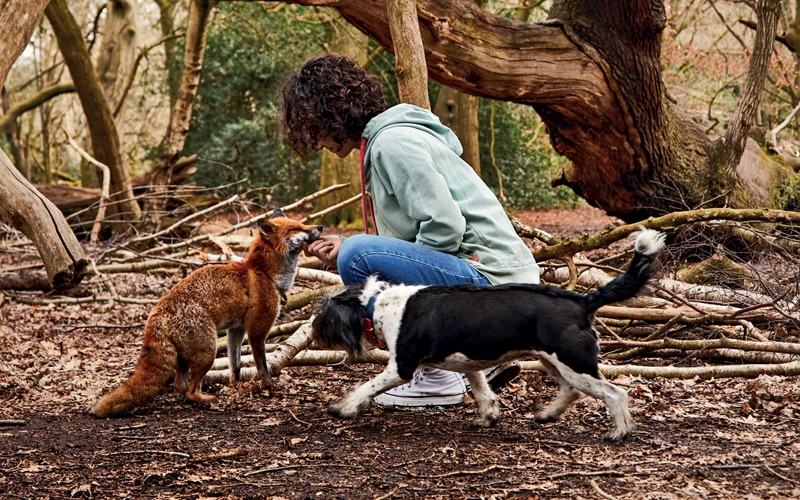- HOME
- /
- Features
- /
- Animal Stories
- /
City Gone Wild
Can London’s people and animals learn to live together?
 Ana Lapaz-Mendez with Pumpkin the fox.Photo Courtesy: Jess Hand
Ana Lapaz-Mendez with Pumpkin the fox.Photo Courtesy: Jess Hand
“I’m sorry, but this is really dangerous,” the irate man shouts, gesturing to his pet beagles, then to Pumpkin the fox, walking peacefully on a lead. We’re in London’s Hampstead Heath, and I’m bombarding Pumpkin’s companion, veterinarian Ana Lapaz-Mendez, with questions about what it’s like to live with a fox. Evidently, I’m not the only one who needs schooling.
Normally, when beagles and foxes meet during a fox hunt, it’s in a horrific bloodbath. But this is different. With well-practised polish, Lapaz-Mendez tells the man that her charge is blind and brain damaged, and has met hundreds of beagles without incident: “Pumpkin doesn’t smell like a fox to them because she’s clean and she lives with dogs.” The man still seems disgruntled but continues on his way.
How did I get here? It started months earlier, when a family of fox cubs was born under my neighbour’s shed. I’d watch them playfighting and sunbathing, round and fat as puppies. One cub liked to come to my window and look in at the comforts of my living room. For a fleeting moment, I felt as though I could let him in and together we’d sit on the sofa and watch television.
Living in London makes for constant encounters with astonishingly bold wildlife: foxes that appear under streetlamps at dusk, pigeons that help themselves to leftover food in pub beer gardens, rodents that navigate your kitchen as if they’re auditioning for a live-action version of Ratatouille. It feels as though these animals are almost tame.
I become fixated on a few questions: Is it possible to adopt a fox, squirrel or pigeon? Is it safe or responsible? What are the limits of friendship between humans and urban wildlife? The best people to answer those questions are the wildlife rescuers who bring injured and orphaned animals home.
 Unlike most foxes, Pumpkin isn’t wary of humans or dogs. Photo Courtesy: Jess Hand
Unlike most foxes, Pumpkin isn’t wary of humans or dogs. Photo Courtesy: Jess Hand
Lapaz–Mendez and I sit in a booth at a pub near Hampstead Heath as she pets Pumpkin, as docile as any lapdog. For a moment, my fox-adoption dreams feel tantalizingly possible. But Lapaz-Mendez stresses that Pumpkin is hard work. “Foxes are like a cross between a dog, a cat, and a ninja,” she says. “They are so intelligent, smart, very cheeky. I currently have fox cubs in my house and they’ll drive you mad within a day—they jump to incredible heights and chew everything. They’re cute, but they’re wild animals.
”Pumpkin is rare: She’s lost her natural wariness of humans because she has toxoplasmosis, a parasitic infection that has reduced her level of fear. Lapaz-Mendez is pretty singular too: She’s a vet who’s built expertise in treating wild animals, while most of her colleagues confine themselves to domestic and farm animals. She’s one of a loyal band of animal rescuers who urge people to value urban wildlife as much as they prize their pets.
“Not many people can keep cats and dogs in London because of money or their tenancy situation, so friendship with squirrels is the next best thing,” says Natalia Doran, whose non-profit organization, Urban Squirrels, rehabilitates injured and orphaned squirrels in her west London home.
Doran began rescuing squirrels as a way of helping her animal-loving autistic son, but she quickly fell in love with them too. “I admire their intelligence, which means they make friends with people very quickly,” she says.
Still, every friendship needs boundaries. “I would never recommend that someone keeps a wild squirrel as a pet,” says Doran. “They’ll be climbing up your curtains and chewing things they shouldn’t be chewing.”
Although grey squirrels would make nightmare housemates, they started out in the U.K. as glorified pets, brought from the United States by meddling Victorian gentlemen such as the 11th Duke of Bedford, who thought they made a picturesque addition to his country estate.
London’s grey pigeons have a similar origin story. “Common city pigeons don’t belong in the wild,” says part-time bird rescuer Alberto Lopez. “They’re descended from birds that escaped from captivity, so they make wonderful pets. If you bond with a pigeon, it’s an amazing experience. It’ll come and sit on your shoulder and preen you. They have the same complex emotional sentience as a dog or a cat.”
Lockdown walks in London’s Hyde Park during the pandemic inspired Lopez and his wife, Inese Strupule, to help local wildlife. Now, their flat hosts an ever-changing cast of feathered friends. Two pigeons, Frenchie and Figura, have become doted-upon members of the family.
Still, not all pigeon rescuers feel this way. Beth Crivelli socialized and rehabilitated injured or orphaned pigeons in a converted shipping container in the garden of her east London home, keeping 25 pigeons or so at a time with the aim of creating a flock that she could release together. “We advocate keeping wild animals wild,” says Crivelli, who now lives in Portugal, where she continues to rescue pigeons.
One pigeon, Mauve, was an exception. “She was found as a tiny baby after she fell out of her nest,” she says. “Most pigeons we took in would lose interest in humans, but she always wanted to be with people. We tried to wild her up, but it failed. She loved cuddles, and she liked to sit on your shoulder and preen your hair.”
I’m quickly realizing that the boundaries between wild and tame animals are more porous than you might think. Wild animals are quick to establish reciprocal relationships with humans when it benefits them: Crows have been known to bring gifts for people who feed them. The genetic differences between wild and tame animals are often surprisingly small too. On an isolated farm in Siberia, researchers selected the tamest 10 per cent of successive generations of silver foxes and continued to breed them. As a study report describes, within just six generations, “researchers produced a subset of foxes that licked the hand of experimenters, could be picked up and petted, whined when humans departed, and wagged their tails when humans approached.”
If your human mate was seriously ill, you’d rush them to hospital. But caring for wildlife can be a lot tougher. “It’s very difficult to find a vet who cares about helping wildlife,” says Lopez. “I thought that if I don’t do this myself, no one’s going to do it.”
Things are even worse for sickly squirrels. Doran explains that under British law, giving medical treatment to grey squirrels and re-releasing them into the wild is illegal. She can only rehabilitate them if she takes them in permanently. “It’s heartbreaking,” she says. “If your dog or cat was sick, you’d take them to the vet. But if squirrels get sick, they’ll only euthanize them.”
The law—which is tough on animals, like the grey squirrel, that are defined as invasive non-native species—reflects decades-old attitudes that the only wildlife worth bothering with is the quaint, endangered rural kind, like nightingales or pine martens. And that state of affairs isn’t helped by myths about dangerous London wildlife, like the headline-grabbing ‘crack squirrel’ or the fox that apparently bit a baby. The wildlife rescuers I spoke with were desperate to correct misconceptions.
“Every year, people die in dog attacks, and no one’s saying we should kill all the dogs,” says Lapaz-Mendez. “The problem is that more and more people are trying to feed foxes by hand.” She explains that this familiarity erodes the animals’ caution around humans. But if foxes were left their to own devices, they offer huge benefits: “They hunt a lot of rats.”
How about pigeons? “Pigeons have a really bad reputation,” says Lopez. “People say they carry a lot of diseases, but it’s very, very rare for those to be passed to humans.”
Grey squirrels get the worst rap of all, accused of wiping out their red cousins. But part of the reason for the decline of the red squirrel was the loss of woodland. “We should celebrate the resilience of nature rather than trying to turn back the clock,” Doran says.
It’s a point Emma Marris made in her book Rambunctious Garden. She argues that instead of trying to return nature to an idyllic state, we should embrace species that thrive in the modern world. “The despised invaders of today may well be the keystone species of the future’s ecosystems, if we give them the space to adapt and don’t rush in and tear them out,” Marris writes.
My desire to adopt a fox is dimming. It sounds like incredibly hard work. Plus, my local fox family is becoming more extravagant and dysfunctional, feasting on garbage and crushing flowerpots during their tussles.
Meanwhile, Lapaz-Mendez opened Pumpkin’s Wildlife Hospital in November 2023. The medical facility and rehabilitation centre treated more than 900 wild animals in its first year. Turning a fox into a pet wasn’t what she planned, but it’s worked out pretty well.
“Hopefully there’s a good reason why you came into the world, huh?” Lapaz-Mendez tells Pumpkin, squeezing her close. Getting this close to London’s wild animals is a privilege reserved for a handful of knowledgeable, dedicated rescuers—but the city would be a better place if we all loved foxes, pigeons and squirrels as much as they did.
Time Out (13 June 2023), Copyright © 2023 Time Out England Limited.
For more animal stories, click here.






